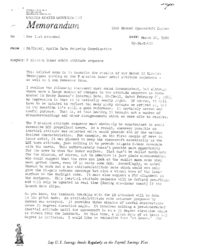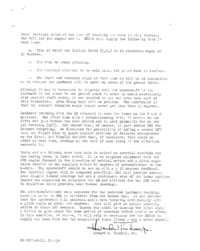See list attachedMarch 20, 196969-PA-T-47APA/Chief, Apollo Data Priority CoordinationF mission lunar orbit attitude sequence
This belated memo is to describe the results of our March 10 Mission Techniques meeting on the F mission lunar orbit attitude sequences – as well as I can remember them.
I realize the following statement must sound inconsistent, but although there were a large number of changes to the attitude sequence as docu- mented in Rocky Duncan's Internal Note, 69-FM-51, dated February 21, 1969, my impression is that it is basically nearly right. Of course, it will have to be updated to reflect the many picky changes we arrived at, but in the meantime it's still a good reference. It certainly served one useful purpose. That is, at this meeting it brought out a number of misunderstandings and minor disagreements which we were able to resolve.
The F mission attitude sequence must obviously be constrained to avoid excessive RCS propellant usage. As a result, whenever possible an inertial attitude was selected which would provide all of the various desired characteristics. For example, on the first couple of revs in lunar orbit, it was planned to keep the spacecraft essentially in the LOI burn attitude, just rolling it to provide hi-gain S-band coverage with the earth. This unfortunately doesn't provide much opportunity for the crew to view the lunar surface. That can't be called mandatory for the mission, of course, but in practice is just plain unreasonable. Who could suggest that the crew not look at the sunlit moon once they have gotten there, even if it costs some RCS. Accordingly, we asked Duncan to work out a new attitude/attitude rate which would not only give the hi-gain antenna coverage but also a visual view of the lunar surface on the daylight side. It must also support a P52 alignment in the darkness. This inertial attitude sequence will be defined pre-flight and will only be updated in real time (during cis-lunar coast) if the launch date slips.
As you know, the landmark tracking with the IM attached will be done in the pitch mode. An attitude/attitude rate sequence proposed by Duncan was accepted. It provides three minutes of useful observations above 55 degrees elevation angle. It involves holding a pre-determined inertial attitude until the spacecraft is at a 35 degree elevation angle as viewed from the landmark. At this time, a pitch rate of at least 0.3 degree is initiated. I would like to emphasize that “at least.” The local vertical pitch at the time of starting the rate is -2.1 degrees; the roll and yaw angles are 0. MCC-H will supply the following data in real time:
a. Time at which the Initial Point (I.P.) is at elevation angle of 35 degrees.
b. The time to start pitching.
c. The inertial attitude to be held until the pitch rate is started.
d. The shaft and trunnion angle at that time as well as an indication as to whether the landmark will be north or south of the ground track.
Although it may be necessary to slightly roll the spacecraft if the landmark is too close to the ground track in order to avoid excessively high sextant shaft rates, it was decided to let the crew take care of this themselves. John Young says it's no problem. The constraint is that the sextant trunnion angle should never get less than 10 degrees.
Landmark tracking with the LM attached is done two times on the F and G missions. The first time with a pseudo-landing site, it occurs on the fifth rev just before the rest period and is used primarily for on the job training (OJT). The second time, of course, is just before DOI for descent targeting. We discussed the possibility of adding a second OJT into the flight plan to guard against problems or failures encountered on the first, but finally decided that, if necessary, this would be added in real time, perhaps at the cost of some sleep if the situation warrants it.
Rocky and his friends have been able to select an inertial attitude for use during sleep in lunar orbit. It is an in-plane alignment with the SPS engine forward in the direction of orbital motion and a pitch angle which results in the sunlight within 40 degrees of perpendicular to the x-axis. The spacecraft should be set up with a ± 10 degrees deadband. The inertial angles will be computed pre-flight and will provide contin- uous hi-gain S-band coverage but not a continuous view of the lunar surface. Duncan was requested to determine the LM yaw attitude for the APS burn to depletion which provides best S-band coverage.
The attitude/attitude rate sequence for the undocked landmark tracking exercise prior to TEI is different from the docked one. It was decided that the spacecraft will maintain orbit rate torquing continuously with a pitch angle of about -20 degrees. This will give an optics tracking period of about 160 seconds. Duncan was asked to tune-up the pitch angle a little to give about the same period of coverage before zenith as after. In this exercise, of course, it will only be necessary for the MCC-H to supply the crew with the two acquisition times (items a and b noted above).
- Apr 15, 1969 – Some things about Descent (5.3σ)
- Apr 08, 1969 – Some things about Ascent from the moon (4.0σ)
- Mar 01, 1968 – Fifth “C” Mission Rendezvous Mission Techniques meeting (3.8σ)
- Oct 25, 1968 – Some more C’ Lunar Orbit Mission Techniques (3.8σ)
- Feb 19, 1969 – All about F APS burn to depletion and landmark tracking (3.1σ)


